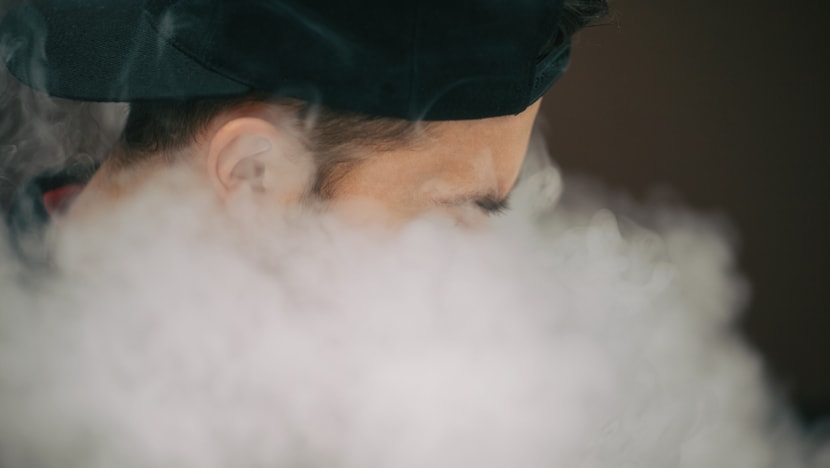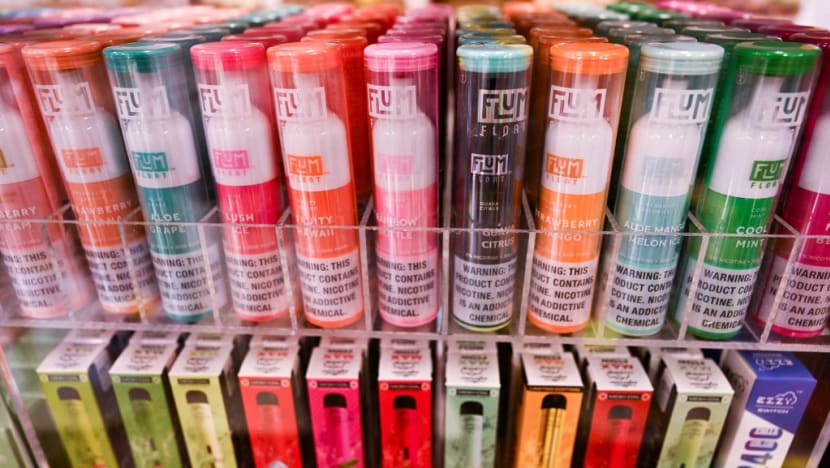Commentary: Teen vaping too big a collateral damage to accept for a relatively ineffective smoking cessation aid
Youths seem to believe vaping is harmless. The reality is far from the truth, says Yvette van der Eijk of the Saw Swee Hock School of Public Health.

File photo of a young man vaping. (Photo: iStock/AleksandrYu)
SINGAPORE: Although the possession and use of vapes is banned in Singapore, vaping is a growing problem. The sight of youngsters vaping in public is increasingly common and, since borders reopened after the pandemic, confiscations of illegal vapes have increased.
According to the Health Sciences Authority, 3,912 people were caught using and possessing vapes between January and August this year. This compares with 4,697 people that were caught for the whole of last year, which in itself was more than triple the number in 2020.
Concerningly, some of them were under age 18, with even primary school students picking up the habit.
Other countries have seen a similar trend, with rates of youth vaping drastically increasing and more pediatric cases of lung disease and injury related to vaping.
Many of these youth seem to believe vaping is harmless. The reality is far from the truth.
YOUNG PEOPLE DEAD AND SERIOUSLY ILL FROM VAPING
In the United States, more than 2,800 people have been hospitalised and 68 people have died because of e-cigarette or vaping-associated lung injury (EVALI) as of February 2020.
EVALI is a severe medical condition with pneumonia-like symptoms and is linked to certain chemicals in e-liquids, notably vitamin E acetate.
The most disconcerting fact of the United States’ experience with EVALI is that most patients were between age 18 and 34. The youngest patient to die from EVALI was just 15 years old.
In Australia, a 5-year-old boy was hospitalised after inhaling a grape-flavoured vape in school.
Lipoid pneumonia is another serious condition that can develop because of vaping.
E-liquids contain a lipid base, such as vegetable glycerin or propylene glycol, to dissolve the other ingredients. Lipids like propylene glycol are safe to ingest, but inhaling them is an entirely different story as the lungs are very delicate and designed to inhale air, not lipids.
The risk of breathing in too many lipids is that they can build up in the lungs, causing a serious type of lung inflammation known as lipoid pneumonia.
Most e-liquids also contain nicotine, which is not only highly addictive but also has its own set of health risks.
Nicotine narrows the blood vessels which can cause heart disease. It has metabolic effects which can increase the risk of diabetes. It also suppresses the immune system and acts as a tumour promoter, meaning it can increase the spread of cancer around the body.
Many e-liquids contain carcinogens such as formaldehyde and acetaldehyde, and heavy metals such as nickel, tin and lead that leach from the vaping device into the vapour.
E-liquids also come in thousands of different varieties, each with different flavours and additives that have their own set of risks. Most of these have not been safety tested for inhalation, and so the long-term impact of vaping these compounds is not known.
Some of them have, however, been linked to serious conditions. Diacetyl, a compound which is used for butterscotch flavour, has been linked to “popcorn lung”, a condition which damages the small airways of the lungs.
Why vaping continues to be a problem amongst youth in Singapore:

WHY DO PEOPLE STILL ADVOCATE FOR VAPING?
Proponents of vaping argue that, despite these health risks, vaping is still safer than smoking and should be made available to current smokers.
There are two major holes in this argument.
First, when assessing the safety and effectiveness of vaping as a smoking cessation aid, it is important to compare it to current treatments on the market. This is the norm in health research. For instance, when testing a new cancer drug, we compare it to available cancer drugs and not having cancer.
Applying this to vaping, we need to compare vaping to current smoking cessation aids, such as nicotine patches, and not smoking.
In terms of safety, given the many potential health risks associated with vaping, nicotine patches and other smoking cessation drugs on the market are far safer than vaping.
In terms of effectiveness, studies so far show that vaping is either similar or less effective than current smoking cessation aids, as most smokers who switch to vaping do not quit completely – they become dual users of both vaping and tobacco products.
Even Hon Lik, the man credited with inventing vapes to quit smoking in 2003, is reportedly still smoking cigarettes and is now a dual user of vapes and cigarettes.
Second, allowing a legal market for vaping products will inevitably lead to rise in youth vaping as they are unaware of the health risks, and are attracted to the many flavours and designs.
Vaping products are aggressively marketed on social media platforms such as TikTok, YouTube and Instagram. A study by the NGO Campaign for Tobacco-Free Kids found that paying young influencers to promote these products is a common marketing tactic.
Of course, the vaping companies continue to claim they do not target youth or non-smokers.
Tobacco companies, similarly, have always publicly claimed that they only target adults. Meanwhile, they were marketing cigarettes with cartoon characters and, in internal communications, described teenagers as their most important target market, terming them “replacement smokers”.
Actions speak louder than words. The many alluring designs and flavours of vaping products, and the social media marketing campaigns used to promote them, make it clear who their target market is.
YOUNG PEOPLE ARE COLLATERAL DAMAGE
To allow a teen vaping epidemic, given its many potential health consequences, is a massive collateral damage to accept for a smoking cessation aid that does not fare much better than nicotine patches.
Having a regulated system, for instance by treating vaping products as medicines, is an option. In this case, they would be tested using the usual standards and procedures for medicinal products, and be made available to smokers using a prescription system.
Vaping companies have actually had the option to pursue this route in Singapore since vaping products first appeared on world markets. Yet none have applied for a medicinal licence.
In April 2019, the Health Ministry said in a parliamentary written answer that it was “open to companies registering a specific e-cigarette product under the Health Products Act as a therapeutic product for smoking cessation”, if they can provide sufficient evidence that their product is safe and effective.
If the companies were serious about helping smokers quit and avoiding a teen vaping epidemic, surely they would have pursued this option by now?
Perhaps it’s time for proponents of vaping to admit that it is just another gateway to addiction and disease.
Yvette van der Eijk is Assistant Professor at the Saw Swee Hock School of Public Health, National University of Singapore.



















